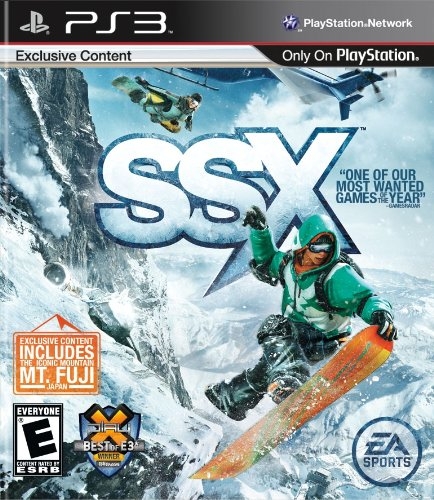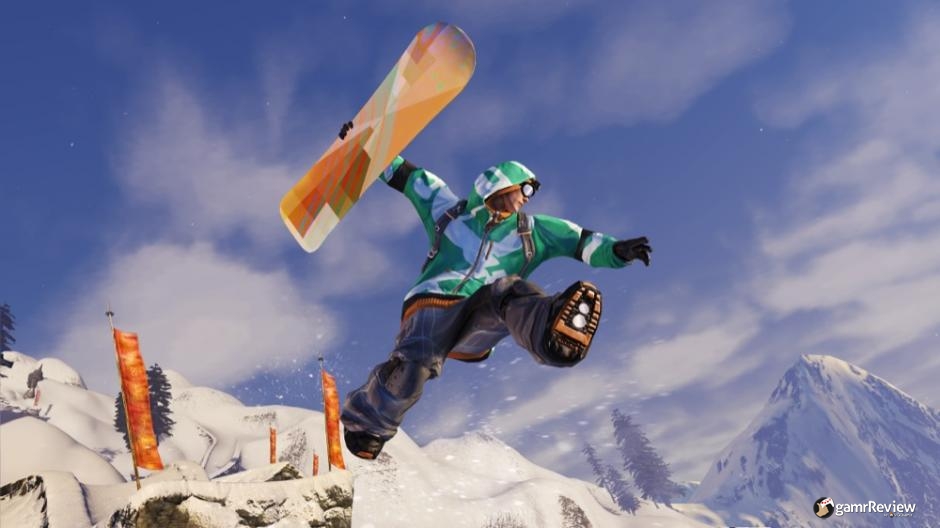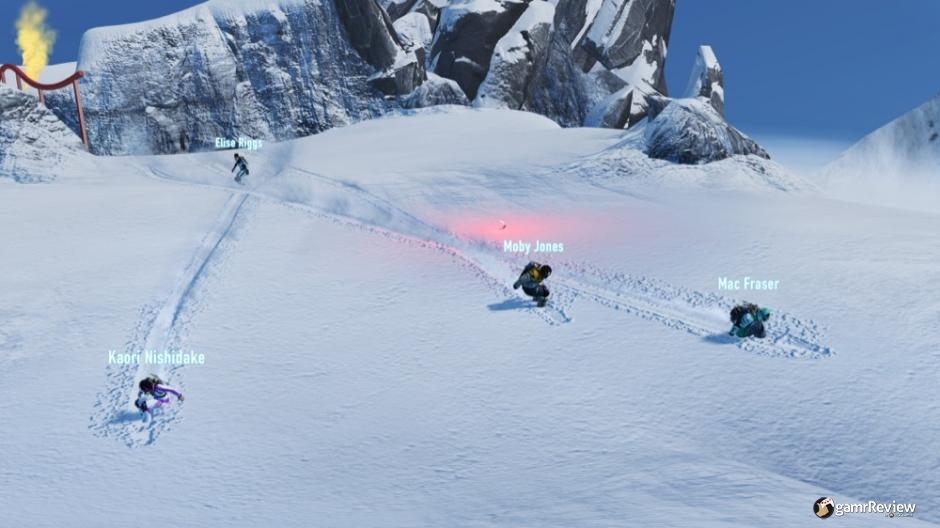Existing User Log In
New User Registration
Register for a free account to gain full access to the VGChartz Network and join our thriving community.





America - Front


America - Back

SSX is a franchise that first hit the powder when extreme sports were just coming into their own. The X-Games were all the rage and Tony Hawk had his name on one of the most successful video game franchises in existence. Those days have come and gone. Tony Hawk has given way to younger names, extreme sports games have become niche titles, and we had a winter nearly devoid of real snow. SSX hasn’t seen real success since 2003’s SSX 3, but Electronic Arts finally saw fit to bring the franchise back. Man, it’s great to hit the slopes again.
This new SSX has a story carving its way down the mountain, at least as much story as a snowboarding game needs. The SSX team has decided to conquer all the most dangerous peaks in the world. At the last minute, Griff leaves team SSX and takes most of their funding with him. Now they’re racing against Griff to conquer the peaks and steal his thunder, gaining funding through viral marketing and a rabid fanbase. So you take control of SSX veteran Zoe and tour around the world recruiting new members from slope to slope. Some are old faces like Psymon, Mac, and Elise. Others are fresh-faced new arrivals to the SSX universe. The story is adequate. More importantly, it doesn’t get in the way of the gameplay. Oh, the gameplay.
Fans of the old school SSX games and newcomers alike will be excited to know the game offers three different control schemes. The first is a new scheme using the face buttons for tricks, shoulder buttons for tweaks and other abilities, and sticks for control. This is the deepest and most versatile scheme, allowing control of specific hands to specific parts of the board. The second control scheme is taken from the Skate franchise, relying mostly on the dual analog sticks. Finally, a classic control scheme is available that harkens back to old school PlayStation 2 SSX games. This variety allows old veterans to jump in like they never left and new players to grab hold of the new and more intuitive schemes.
There are some true innovations and additions to the classic SSX gameplay. Non-rail grinding surfaces can only be utilized using a supplementary button, adding a new challenge. Gone are the manual or automatic resets for falling or getting stuck. These were often abused in previous SSX games, so their absence is great. In its place is a rewind system. Falling to your doom, getting stuck, or just plain screwing up can be corrected by holding a button to rewind. While it has its benefits, it’s balanced; rewinding in a trick event will cost you points, and rewinding during a race doesn’t rewind or slow down your competitors. Deadly Descents severely limit your rewinds as well.

There are no bunny slopes in SSX, only hardcore, triple black diamond monsters to tackle. The layout of each course allows for multiple ways to attack them. Riders more adept at big jumps and linking combos will find certain paths more challenging but also more rewarding. Easier times can usually be had with extensive grinding throughout many courses as well. This new SSX is significantly more brutal than ever with the addition of the Deadly Descents. In these, players face particularly deadly elements such as gravity, white-outs, avalanches, rocks, and more. Different equipment, like glider wings, armor and oxygen tanks increase the chance for survival in these events, but the trial-and-error nature of most of them is frustrating. It becomes more about finding the perfect line through repeated attempts than true skill or better equipment.
The different peaks look and feel good, but not great. The HD treatment has been long overdue for the SSX franchise, but it leaves you feeling like they could have done a bit more, too. Having just seen some brilliant snowy mountain scenes in Need for Speed: The Run, it makes me wonder why Electronic Arts didn’t use the Frostbite engine for SSX, which would have dramatically improved the graphics. Sadly, the completely open exploration of SSX 3 is absent once again, using a gorgeous graphical menu system to navigate the world and its peaks instead.
As far as riders go, the new SSX mostly goes the route of SSX 3. There are recognizable characters from the SSX universe, but they aren’t bursting at the seams with personality like they were in SSX Tricky, something fans will still miss from that entry. There are also no build-your-own customizable riders, but that's something most fans won’t miss. Each rider excels at different skills and can level up by competing in events. They can also be customized with different outfits, boards, and other equipment. As in SSX of old, the boards are where your skills really increase and different boards will be better suited for different events. The outfits are mostly aesthetic, but some rare and expensive outfits have bonus perks that really come in handy. Single-use mods can be equipped to give a boost to a specific attribute, while GeoTags can be equipped, then left in Explore or Global Events for other riders to try to pick up. The more riders go through an event without picking up your GeoTag, the more bonus XP and credits you’ll earn. It’s all about challenging GeoTag placement.

SSX really excels at providing the player with loads of content. The main story takes 6-8 hours to complete and it lets you skip events that are giving you trouble. There’s also an Explore mode that allows you to go to any peak and any event to trick it, race it, or survive it with any of the riders you’ve unlocked. Then there are Global Events. These are akin to Gran Turismo 5’s seasonal events except there are always a ton of them. All over the globe, there are events that dozens, hundreds, or even thousands of people are competing in every day. Some are free to enter, but most use your SSX credits as an entry fee. Depending on what tier you rank in, you’ll get a payout. Some of these payouts are tremendous, particularly as the entry fees increase. Both the Explore and Global Events utilize RiderNet, a translation of Need for Speed's Autolog into a snowboarding network. RiderNet maintains leaderboards and ghost data while notifying players of what their friends are doing in SSX.
Despite the brilliance of RiderNet, there is no active multiplayer whatsoever. You cannot jump online with a friend and race or go head-to-head in a trick run. Having a friend over to ride the ski lift and carve up the mountain together won’t help either - SSX has no local multiplayer elements. Add in the lack of the Frostbite engine and you get a clear picture of SSX: Electronic Arts wanted to bring this franchise back on the cheap. Active online multiplayer requires a lot more coding and server work than ghost data and leaderboards. The same goes for split-screen multiplayer. The Frostbite engine is relatively new and would require teaching its new technologies to a new bunch of programmers and artists. Electronic Arts wanted to bring SSX back, but they didn’t want to go all in and make it a AAA title, and it shows. The end result is a rather good game, and something SSX game fans have clamored for all generation. Sadly, it falls well short of brilliance.










| Total Sales |
0.02m
Japan |
0.35m
NA |
0.42m
Europe |
0.13m
Others |
0.92m
Total |
| 1 | n/a | 97,934 | 77,603 | 32,404 | 207,941 |
| 2 | n/a | 24,970 | 36,077 | 11,991 | 73,038 |
| 3 | 7,140 | 8,784 | 19,399 | 5,755 | 41,078 |
| 4 | 2,453 | 6,784 | 12,429 | 3,860 | 25,526 |
| 5 | 1,270 | 6,560 | 10,735 | 3,438 | 22,003 |
| 6 | 790 | 8,695 | 13,920 | 4,486 | 27,891 |
| 7 | 592 | 8,079 | 9,338 | 3,345 | 21,354 |
| 8 | 477 | 3,974 | 5,780 | 1,918 | 12,149 |
| 9 | 499 | 1,980 | 4,966 | 1,433 | 8,878 |
| 10 | 599 | 1,204 | 4,225 | 1,147 | 7,175 |
|
|
|
|
|
|
|
|
|
|
|
|
|
|
|
|
|
|